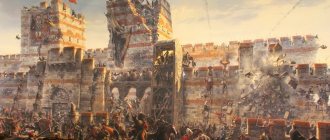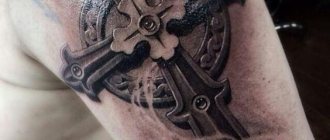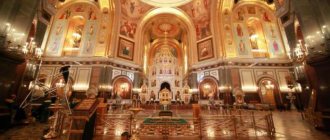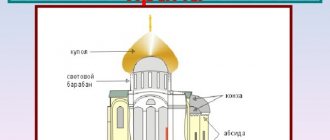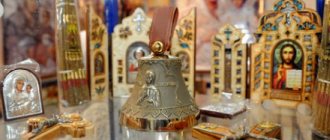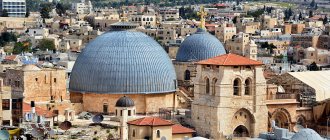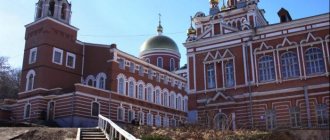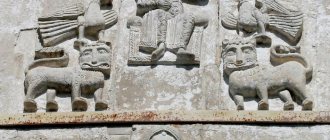By studying the history of states, you can learn a lot of interesting and incredible things. Most people in the 21st century do not even ask basic questions about the symbolism of countries and continents. And if you look closely and delve deeper into history, it turns out that states that are currently unconnected previously had strong ties. One of these countries is Byzantium.
This is what the last flag of the Byzantine Empire might have looked like:
Flag of Byzantium
Byzantine heraldry
Did the flag and coat of arms of the Byzantine Empire exist? First of all, we note that the history of Byzantine heraldry covers a relatively short period of the existence of this powerful state. This is due to the fact that heraldry appeared only in the 12th century.
At official state events, certain emblems and symbols were often used. They were also depicted on banners and shields. The most common such symbols were the labarum (the state banner of great imperial Rome) and the cross.
Historians also know that some symbols were also displayed on seals. Most often it is a cross, an image of the Virgin Mary and Jesus Christ, various saints. However, for the most part it was more personal than family symbolism.
Single headed eagle
Let us turn to the history of the coat of arms of the Byzantine Empire. As successor to the Roman Empire, it continued to use the single-headed eagle as its symbol, but rather rarely.
There was even such a position as “eagle bearers.” These warriors performed the same mission as the Roman aquilifers. These are the standard bearers who carried the legion's eagles in their hands. In particular, the “eagle bearers” are mentioned in the military treatise “Strategikon of Mauritius”. But it is not known how similar their standards were to Roman aquilas.
The coat of arms of the Byzantine Empire, a single-headed eagle, began to be depicted on coins from the 7th century. Sometimes it could be found on reliefs and seals. It is known that in the last centuries of the empire’s existence such a coat of arms was also embroidered on palace fabrics. Thus, in illuminated manuscripts one can see images of embroidered imperial pillows with single-headed eagles.
Ceremonial sign
Ceremonial miniature labarum
, worn by the triumphant 10th century Emperor
Güntertuch.
From the 6th century until the end of the empire, the Byzantines also used a number of other insignia. They are mainly recorded in ceremonial processions, especially in De Ceremoniis
10th century, but they may also have been carried over into the battle.
When not in use, they were kept in various churches in Constantinople. These included imperial flamules
made of gold and gold-embroidered silk, as well as insignia known collectively as "sceptres" (σκῆπτρα,
skēptra
), which were usually symbolic objects on a staff.
Some of them, the so-called "Roman sceptres" (ῥωμαϊκὰ σκῆπτρα, rhōmaïka skēptra
), resembled an old
vexilla
with hanging cloth (βῆλον,
vēlon
, from Latin
velum
).
Other signs of this type included the eutychium
or
ptychium
(εὐτυχία or πτυχία), which probably bore some kind of image of Victory.
Another group known collectively
by the name
skeue
(σκεύη), mentioned in
De Ceremoniis
, mostly old military standards passed down through the centuries.
They were laboura
(λάβουρα), probably a form of
labarum
;
the kampēdiktouria
(καμπηδικτούρια), descendants of the batons of Late Roman drillers or
campiductores
;
Signa
(σίγνα, “sign”);
drakontia
(δρακόντια) and
Banda
.
The drakontia
are clearly descendants of the old Roman
Draco
, and the term
Drakonarius
for standard-bearer survived into the 10th century.
However, it is unknown what later standards looked like. According to Niketas' description of Choniates, they still included the Windsock, which was Draco
's signature feature, but this may be deliberate archaicism. In any case, the use of the dragon as an image is well attested as early as the 14th century.
Pseudo-Kodinos also lists the various banners and insignia used in imperial processions: one is called archistratigos
(ἀρχιστράτηγος, "chief general");
another with images of famous prelates and eight streamers known as octapodions
(ὀκταπόδιον, "octopus");
the other in the form of a cross with images of St. Demetrius, St. Procopius, St. Theodora Tiro and St. Theodora Stratelates; another depicts St. George on horseback; another in the form of a dragon (δρακόνειον, draconeion
);
and another with the emperor on horseback. A pair of each existed, and they were carried in processions, and one or two copies were taken during the campaign, depending on the size of the imperial escort. They were always preceded by the scouterions
with
the dibellion
(διβέλλιον), the personal banner of the emperor, together with the imperial shield (
scuterion
), and followed by the banners of the despots and other commanders with the banners
of the demarchs
(heads of the quarters of Constantinople), marching to the rear.
The dibellion
's nature has been debated, but its name—most likely a mixed Greco-Latin compound meaning "double
sail
"—appears to describe a forked pennant, apparently of Western European origin.
The appearance of the double-headed eagle
The double-headed eagle is also considered the coat of arms of the Byzantine Empire. It is a more common symbol here. But this heraldic image was not created by the Byzantines. It was borrowed from peoples with a more ancient culture.
Today, historians know that the motif of the heraldic double-headed eagle belonged to the Anatolian tradition and its origins went back to the Hittite culture. The Byzantines began to use it as the coat of arms of the Byzantine Empire in the last years of the existence of the state.
Some historians date the appearance of such an emblem in Byzantium to the mid-11th century. It is explained that it was then that the Komnenos (an imperial Byzantine dynasty) may have adopted this symbol from the stone paintings of Hittite times in their home region of Paphlagonia.
But such a point of view is still considered erroneous in wide circles. Yes, in the decorative art of Byzantium, the first images of the double-headed eagle really began to appear only in the 11th century. It became an imperial symbol, the coat of arms of the Byzantine Empire only under the Palaiologos (the last and longest-lasting imperial dynasty in Byzantium), already in the 13th century.
It is also known that in the 12th century this symbol was used not only by Byzantium. A number of Asian rulers adopted the double-headed eagle as an element of palace decor and as their own emblem. For example, the sultans Kay-Kubad, Salah ad-Din, the Zangid and Artukid dynasties.
Byzantium was never a backward country
On the contrary, for a long time it was the Eastern Roman Empire that was considered the most cultural and developed country in the Christian world. While in the West the church tried to preserve the last remnants of science and literature, in the East philosophical, theological, and literary schools flourished with might and main. Many scientists worked in the fields of exact and natural sciences. Even the first European university appeared in Byzantium.
It is generally believed that Bologna, founded in 1088, was the first. But in Constantinople, even under Emperor Theodosius II in the 5th century, a court school arose. Even then, a classic set of disciplines for medieval universities was studied there: theology, law, rhetoric and medicine. In 855, through the efforts of the outstanding scientist Leo the Philosopher, the school was transformed into a university and received at its disposal the Magnavra Imperial Palace on the Augusteon, the main square of the capital, where the St. Sophia Cathedral was also located.
Lev the Philosopher became the first rector of the world's first university and the actual creator of the modern system of higher education, which was the focus of European enlighteners. The Magnavra High School existed until 1453, and its last professors fled from the Ottoman conquest to Western Europe.
Evgeny Bashin-Razumovsky Expert on historical issues
The empire of the empire is discordant, of course, and the same Fourth Crusade greatly broke it.
Description
Let's imagine a description of the coat of arms of the Byzantine Empire. This is an armorial figure in the form of a mythical eagle with two heads. One of them looks strictly to the right, the other to the left. There were also such variations: the coat of arms had two eagles located one behind the other. From the one in the background, only the head was visible.
It is no coincidence that the two heads are depicted here. They don't just look straight left and right. One of them seems to be facing the west of the empire, and the other is facing the east.
The symbol thus represents the unity of Asia and Europe, West and East. The double-headed Byzantine eagle is a symbol of the greatness of power and its divinity.
Byzantium maintained cultural continuity with Antiquity
While in many regions of Western Europe, after the fall of Rome, an era of decline began and much of the cultural and scientific heritage of the past was forgotten, in the Eastern Roman Empire there was no such civilizational turning point at all. Until the end of their state, the Romans felt themselves to be heirs to the culture of ancient Greece and Rome, they knew ancient literature well and studied it. The libraries of Constantinople and other cities of the empire were the envy of any European scientist, until the conquest of the country by the Ottoman Turks, when a considerable part of the book treasures was destroyed by Muslim fanatics.
On the same topic
Iconoclasm: the first attempt at church reformation
“If the same is written in these books as in the Koran, then they are superfluous. If otherwise, then they are lying,” said Caliph Umar, who ordered the burning of the Library of Alexandria after the Arabs expelled the Byzantines from Egypt.
Many ancient sources that have survived to this day remain intact precisely because the Romans preserved them. When, after the fall of Constantinople, a crowd of Greek scholars and ancient books poured into the West, European humanists were amazed at what treasures of thought were hidden in the East.
Symbol of the Palaiologos
You can see a photo of the coat of arms of the Byzantine Empire in the article. But this is only a symbolic name for the double-headed eagle. Most historians consider it the emblem of the last Byzantine dynasty - the Palaiologos. This was a symbol of the older family members. It is known that he was depicted on regalia and embroidered on imperial clothes. In particular, the image of the mythical bird could be seen on the boots of the last Byzantine emperor, Constantine XI Palaiologos.
Once an eagle could be seen on the flag of a ship - the ship on which John VII Palaiologos sailed to the Ferraro-Florence Cathedral. Sfrandzi has evidence of this. This ship is also depicted on the door of Filaret in St. Peter's Basilica.
Flourishing Cross
Flourishing cross. Reverse side of the icon of the Descent into Hell. Byzantium. X-XI centuries Georgia. Tbilisi. Art Museum
Even more specifically, a parallel is drawn with the heavenly Tree of Life in the image of the “flourished” cross. In this type of image, branches and leaves emerge from the base of the cross. Sometimes it is just a conventional floral ornament or a vine with leaves and clusters. In this context there is an additional eucharistic meaning.
Other borrowings
The history of the coat of arms of the Byzantine Empire shows that the Palaiologans borrowed it from more ancient peoples and cultures. But the series of borrowings did not stop with Byzantium.
This coat of arms was also considered the emblem of the rulers in the lands subordinate to Byzantium. For example, in Lesbos, in the Despotate of Morea. He was depicted not only on imperial clothes, but also on the flags of the Trebizond Empire.
If we turn to Western European portolans (nautical charts) of the 14th-15th centuries, we will see that the golden or silver double-headed eagle was more often understood and noted as a symbol of Trebizond, rather than the Byzantine Empire.
If we consider the history of the coat of arms and the fall of the Byzantine Empire, we can find out that at the same time as the double-headed eagle, the image of a single-headed eagle was also used in those days. Moreover, both in the symbolism of Byzantium and in the symbolism of Trebizond. It was also minted on coins and depicted on flags.
After the fall of the great empire, the Byzantine symbol was adopted by other states - Bulgaria, Serbia, Albania. Also, since 1472, it became the coat of arms of the Russian state. It is known that along with the single-headed eagle, the Holy Roman Empire of the time of Frederick the Second also began to use the double-headed one.
Russian coats of arms
Let's take a closer look at how Russia became the successor to the Byzantine coat of arms. Before this, in Rus' in the XII–XIV centuries. there were already city, grand-ducal heraldic symbols. Thus, it was known that the ancient Moscow coat of arms was a horseman slaying a dragon with a spear.
But over time, the borrowed Byzantine symbol began to play the main role. But how did he appear in Russia? There are many stories, legends and myths about this. This happened about 500 years ago. Let's present the most proven version.
“Constantinople” was not the only name for the capital
The capital of the empire, the greatest city of the Middle Ages, standing on the banks of the Bosphorus, was called New Rome from its founding.
Evgeny Bashin-Razumovsky Expert on historical issues
This city has a whole set of names in historical documents: “Royal City”, “Eternal City”, and even “Byzantium”.
Constantinople (city of Constantine) is not just an unofficial name, but rather a poetic one, found in literature. As in Russia, St. Petersburg is sometimes called the city of Peter. Constantine - founder of New Rome; Any citizen of the empire knew this fact, but we will not find the name Constantinople in any official document. Although now this name is widely used in scientific works and fiction and has become familiar to everyone.
The appearance of the double-headed eagle in Russia
The borrowing of the Byzantine coat of arms by our state dates back to 1472. It was then that the marriage of the Great Moscow Prince Ivan the Third and the Byzantine princess Sophia from the Palaiologos family took place. Under this ruler, the unification of Russian lands was finally completed. There were other significant positive changes: dependence on the Golden Horde completely disappeared, trade relations with Western Europe began to be established. The Code of Laws was adopted - a single set of laws for the entire Moscow state.
What prompted the Grand Duke to adopt a new coat of arms for the state? First of all, the desire to perform on the international stage on an equal basis with Western European rulers. In addition, in the coat of arms he wanted to capture the relationship that had formed with the imperial dynasty. To become related to the Byzantine royal family was then considered a great honor for the rulers of even the most powerful states.
In addition, such a coat of arms emphasized an idea that was important for those times in Russian history: “Moscow is the third Rome, and there will never be a fourth!”
Russian modifications
Having become a symbol of the Moscow State (and then the Russian Empire, the Russian Federation), the double-headed eagle underwent some changes:
- Ivan the Third combined this image with the Moscow coat of arms - St. George the Victorious, slaying the serpent with a spear.
- In the 17th century, an orb and a scepter began to be depicted in the paws of the coat of arms bird. These were the traditional regalia of monarchical states.
- Fyodor Ioannovich placed an Orthodox cross between the heads of an eagle crowned with crowns. This is no coincidence - in 1589 the patriarchate was established, which meant the ecclesiastical independence of Russia.
- Under Mikhail Romanov, the image of St. George the Victorious was again added to the eagle’s chest.
- Paul the First added Maltese symbols to the Russian coat of arms - a crown and a cross. Under Alexander the First it was removed.
- After World War II, the eagle began to be depicted with spread, lowered wings. In his paws he began to hold a wreath, a torch and lightning instead of an orb and a scepter.
- Under Alexander the Second, the heraldic symbol underwent the most serious changes. The ruler created a special Stamp Department for this purpose. The image of both the eagle and St. George the Victorious was changed. The new coat of arms was approved in 1857. In this form it existed until the fall of the Russian Empire in 1917.
Its successor, the USSR, abolished the royal heraldic sign. Instead, a completely different coat of arms began to be used - the hammer and sickle.
Sources
- Androudis, Pascal (2017). "Présence de l'aigle bicéphale en Trebizonde et dans la Principauté grecque de Théodoro en Crimée (XIVe-XVe siècles)" (PDF). Byzantium
(in French).
34
: 179–218. ISSN 1012-0513. CS1 maint: ref=harv (link) - Baboon, A. (2001). "Standards and insignia of Byzantium." Byzantion: Revue internationale des études byzantines
.
71
(1):5–59. CS1 maint: ref=harv (link) - Bees, Nikos A. (1912). "Zum Thema der Darstellung des zweiköpfigen Adlers bei den Byzantinern". Repertorium für Kunstwissenschaft
(in German).
XXXV
: 321–330. CS1 maint: ref=harv (link) - Cernovodeanu, Dan (1982). "Contributions to l'Etude de l'heraldique Byzantine and Post-Byzantine". Jahrbuch der Österreichischen Byzantinik
.
32/2
: 409–422. CS1 maint: ref=harv (link) - Dennis, George T. (1981). "Byzantine battle flags". Byzantinische Forschungen
.
8
: 51–60. CS1 maint: ref=harv (link) - Furlas, A. (1980). “Adler und Doppeladler. Materialien zum" Adler in Byzanz ". Mit einem bibliographischen Anhang zur Adlerforschung.” Philoxenia: prof.
Dr. Bernhard Kötting gewidmet von seinen griechischen Schülern (in German). Münster: Aschendorf. pp. 97–120. ISBN 9783402036518. CS1 maint: ref=harv (link) - Gerola, G. (1934). "L'aquila bizantina e l'aquila imperiale a due teste." Felix Ravenna
(in Italian).
43
: 7–36. CS1 maint: ref=harv (link) - Grierson, Philip (1999). Catalog of Byzantine Coins in the Dumbarton Oaks and Whittemore Collections, Volume 5, Part 1: Michael VIII to Constantine XI, 1258–1453.
Introduction, appendices and bibliography . Washington, DC: Dumbarton Oaks. ISBN 978-0-88402-261-9. CS1 maint: ref=harv (link) - Grosse, Robert (1924). “Die Fahnen in der römisch-byzantinischen Armee des 4.-10. Jahrhunderts." Byzantinische Zeitschrift
(in German).
24
(2): 359–372. DOI: 10.1515/byzs.1924.24.2.359. CS1 maint: ref=harv (link) - Hendy, Michael F. (1992). Byzantine Coins in the Dumbarton Oaks Collection and the Whittemore Collection, Volume 4, Parts 1-2
. Washington, DC: Dumbarton Oaks. ISBN 978-0-88402-233-6. CS1 maint: ref=harv (link) - Haldon, John (1990). Konstantin Porphyrogenite.
Three Treatises on Imperial Military Expeditions . Vienna: Verlag der Österreichischen Akademie der Wissenschaften. CS1 maint: ref=harv (link) - Kazhdan, Alexander, ed. (1991). Oxford Dictionary of Byzantium
. Oxford and New York: Oxford University Press. ISBN 0-19-504652-8. - von Koehne, Bernhard (1871–1873). "Vom Doppeladler". Berliner Blätter für Münz-, Siegel- und Wappenkunde
(in German).
6
: 1–26. CS1 maint: ref=harv (link) - Macrides, Ruth J.; Munitiz, Joseph A.; Angelov, Dimiter (2013). Pseudokodinos and the Court of Constantinople: Offices and Ceremonies
. Ashgate. ISBN 978-0-7546-6752-0. CS1 maint: ref=harv (link) - Popovic, Bojan (2009). "Imperial use of zoomorphic motifs on textiles: double-headed eagle and lion in circles and between crosses in the late Byzantine period." Icon
.
2
: 127–136. DOI: 10.1484/J.IKON.3.36. ISSN 1846-8551. CS1 maint: ref=harv (link) - Soloviev, A.V. (1935). "Hieraldic emblems of Byzance and slaves". Seminary Condakovianum
(in French).
7
: 119–164. CS1 maint: ref=harv (link) - Typaldos, G.E. (1926). "Εἶχον οἱ Βυζαντινοί οἰκόσημα;". Ἐπετηρίς Ἐταιρείας Βυζαντινῶν Σπουδῶν
(in Greek).
III
: 206–222. LVP: 11615/16885. CS1 maint: ref=harv (link) - Tsamakda, Vasiliki (2002). Illustrated Chronicle of John Skylitzes in Madrid
. Leiden: Alexandros. ISBN 978-9-0806-4762-6. - van Millingen, Alexander (1899). Byzantine Constantinople: The City Walls and Adjacent Historic Sites
. London: John Murray Ed. CS1 maint: ref=harv (link) - Verpo, Jean, ed. (1966). Pseudo-Codino, Traité des Offices
(in French). National Center for Scientific Research. CS1 maint: ref=harv (link)
Modern use
As for modern states, many of them are successors to the Byzantine symbol:
- RF. Since 1993, the symbol of the state has been a double-headed golden eagle with a scepter, an orb and outstretched wings. He is crowned with three crowns.
- Albania. The symbol is represented on the flag, coat of arms, lek.
- Armenia. The eagle is depicted in the upper right corner of the shield on the coat of arms.
- Serbia. It is depicted not only on the flag, coat of arms, but also on postage stamps and other government documentation.
- Montenegro. The image is used on the coat of arms and flag.
Also, the double-headed eagle was depicted on the flag and other symbols of the unrecognized state of the Donetsk People's Republic.
Both the single-headed and the double-headed eagle were considered the Byzantine coat of arms. However, the history of this symbol goes back centuries - to Hittite times. The eagle was borrowed from Byzantium by other states, including Russia.
